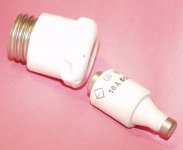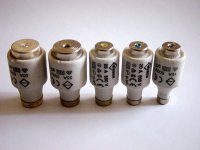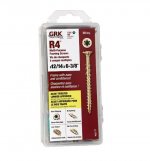No. They were all-porcelain with much bigger protruding grabber than American. And you had to screw it out and inspect to see if it is blown. Will try to find a picture on the web.I don't remember seeing those, but I didn't poke around in peoples fuse boxes at home. Did they look like the North American type?
I got some adapters in Hyderabad for using bayonet lamps in 14 and 22 mm screw based fixtures, quite cheap, about 25 cents each.
Both types were available, screw base in lamp to bayonet wall / chandelier mount, and bayonet lamp to screw base in wall / lamp.
They might be available in your area, if needed.
Here MCB is compulsory at lighting inwards at supply / meter end. Most people use fuses also, some do not, and the breakers fail at a bad time.
Both types were available, screw base in lamp to bayonet wall / chandelier mount, and bayonet lamp to screw base in wall / lamp.
They might be available in your area, if needed.
Here MCB is compulsory at lighting inwards at supply / meter end. Most people use fuses also, some do not, and the breakers fail at a bad time.
Um, Mopar had two similar un-slant designs. From poor memory: 1929(DeSoto)-1935 the water jacket did not go to the bottom of the cylinder, 1936-1991 it did. (Israeli Army had a standing order for the Flattie; also generators and forklifts, tho I have also seen the Slant in a forklift.) There were two lengths of the Six, so the radiator brackets were reversable to fit what you had. The Eight was the same with 2 more holes.Does your Plymouth have a Flathead 6 cylinder engine? ........ I know it was also used as far back as 1942
https://www.allpar.com/threads/flat...h-dodge-desoto-chrysler-six-and-eight.229897/
Trucks could have even larger Flathead Six, to 413CID.
As a side-track: mid 1930s someone had a contest for an affordable family airplane. Most of the entries were far above budget. One that was not used a Mopar Six, with a wood propeller designed by a later-famous Swede and machined by my grandfather. The fix was in, it did not win, but another guy got a mail-contract in Alaska and used the prototype. Steady use was a bit too much for the plan and it ended in the surf somewhere.
The Mopar Six did not "stop for war": Mopar churned many-many ambulances, PowerWagons, and Officers' Cars (Plymouths with no chrome). Not to mention the 30-cylinder tank engine. (WWII ate a lot of tanks, and engines limited deployment; MOPAR put five Chrysler 230s on one crankcase for like 400 HP. Critics sneered, and it was heavy and large, but after some upgrades it was very reliable.)
Me too. It's always been 'Metrification' to me in English!I learned a new word today: "metrication"
Hi I'm french, 72 years old. In my youth, all lamps had brass bayonet bases. But with the early "world market" circa '60s, Edison bases invaded the market, mainly from foreign producers. To reduce costs, bayonet bases were made with plastic instead of brass, which broke very often due to heat. This accelerated the move to screw bases, which are everywhere now.Only France and the UK had bayonet base lamps when I was growing up, and in France there were also Edison base. Belgium, Italy and Germany were all Edison to the best of my recollection. UK is still all bayonet, not sure about France.
(All of my parent's lamps are from Italy, and all I had to do was change the plugs and put 120V bulbs in them when they moved here.)
As a teen I rewired all of my parent's indirect living room lighting dating from 1961 when they bought a condo in Brussels all edison screw type bulbs as originally equipped. I had to replace a lot of bulbs. (There were at least 60 of them, and I settled on 15W and 25W lamps - still the best, most evenly lit room I can remember, virtually no shadows, but it was a lot of work)
Nowadays, the most used lamps are the 14mm ones, for the small wattage lamps, either standard, Eco-friendly or LED ones. E27 is only for the big ones (100W and over), which are slowly dying due to ban on big lamps.
E14 are replaced by new small sockets (GU10 and others) in the small LED lamps.
In my house, i have, apart a big 150W bulb in the kitchen, and a very big 400W R7s halogen in the dinnig room, only LED lamps for over 8 years. They give a better light for less watts, but they are not as long-lasting than the pubs say !!
They all come from the far-East, and the european lamp industry is forever gone ... thanks to our leaders ...
I still have 2-3 bayonet-bases lamps, in case ...
LED bulbs need stable supply, and ventilation.
Arcing, heat and fluctuations are bad for their life.
Arcing, heat and fluctuations are bad for their life.
When I grew up in Germany domestic supplies used the Siemens-Schukert fuse system. They came in 5 sizes.Picture == 1k words. Anyone outside of "the new world" used these?
View attachment 1107683
The power panel in my 50 year old apartment... The one with the handle is for the stove. The screw in ones are for the outlets in the living spaces, and the ones between them are 15A cartridge fuses for the kitchen outlets.
I've blown the fuses that are now blue :😛
That stopped when I coated the bottom of the fuse with Vasoline (Or "welfare dielectric grease" LOL)
View attachment 1107684
The fuse cartridges had tiny coloured discs which popped off when the fuse blew. This was visible through a window in the holder.
Attachments
I liked those. There was a gauge ring in the bottom of the holder so you couldn’t fit a bigger fuse than designed for that circuit
I think hex and Torx look cool and use them in what I build. I don’t like that I need a separate tool for each screw size. With NAS/SAE hardware and a good screwdriver (Snap On or Cooper) you could use one tool for 2-3 sizes of hardware; say a crossed recess (Philips) #4 to #8 as long as the #8 wasn’t too torqued.
Interestingly an M5-0.8 is almost the same as a 10-32 (10-31.75) and will fit in some holes.
Robertson are good screws from a design perspective. Most of the screws you can buy are made poorly. They don’t slip when done well.
Interestingly an M5-0.8 is almost the same as a 10-32 (10-31.75) and will fit in some holes.
Robertson are good screws from a design perspective. Most of the screws you can buy are made poorly. They don’t slip when done well.
A good excuse to have 2 sets of wrenches, and 2 sets of drills, taps, and dies. Standardization is good but doesn't accomodate the obsloescence of the lathe in the shop that is 70 years old and cuts inch pattern threads...
Love the Robertson head screws. I was introduced to them in 1980 by SpeakerLab. They don't "cam out" like Phillips.
Love the Robertson head screws. I was introduced to them in 1980 by SpeakerLab. They don't "cam out" like Phillips.
Regarding North American fuses, the whole home electrical system here is like the imperial vs metric debacle. It’s both Jules Verne-esque in its big, chunky metalwork and oversized breaker panels while at the same time uses flimsy, dangerous, unfused plugs and exclusively spur circuits. Ring mains do not exist here!
Worst combination IMO: very expensive in cost and footprint and not very safe.
On the other hand, the UK plugs and sockets are way too chunky and big. As my daughter points out, the UK plugs are the most painful to step on.
Worst combination IMO: very expensive in cost and footprint and not very safe.
On the other hand, the UK plugs and sockets are way too chunky and big. As my daughter points out, the UK plugs are the most painful to step on.
Last edited:
Yes. although many if not all of the new Briggs and Strattons are OHV, overhead valve.Flat head == like a Briggs and Stratton?
The UK plugs are the best designed ones around from a safety point of view, the drawback is that, as you hinted at, a UK plug is the only thing known to mankind that is more painful then a Lego brick to step on.On the other hand, the UK plugs and sockets are way too chunky and big. As my daughter points out, the UK plugs are the most painful to step on.
Yes. In North and Central America we are stuck with the flimsy old Edison plug. It’s small and not sturdy. They do seem to have gotten better over the past 50 years or so.
I like the round pin European mains plug. Sturdy but not overly bulky like the UK monsters. Sturdy enough for stage work, which was super convenient. In the US it was twist lock or stage pin for lights. Both bulky and expensive. But PowerCon is quickly replacing that.
I like the round pin European mains plug. Sturdy but not overly bulky like the UK monsters. Sturdy enough for stage work, which was super convenient. In the US it was twist lock or stage pin for lights. Both bulky and expensive. But PowerCon is quickly replacing that.
My house is only 22 years old and I have replaced most of the duplex receptacles. After a short time they become quite loose.
I have returned some (that I had purchased) to the store (Home Depot). Just rubbish. Weird because it's not as though this is new technology.
I have returned some (that I had purchased) to the store (Home Depot). Just rubbish. Weird because it's not as though this is new technology.
I have been a perpetually barefoot person for most of my life since I grew up in Miami before air conditioning. Playing outside barefoot on asphalt streets was commonplace then. My two youngest grandkids seem quite adept at scattering Legos into the best places for my feet to find them.The UK plugs are the best designed ones around from a safety point of view, the drawback is that, as you hinted at, a UK plug is the only thing known to mankind that is more painful then a Lego brick to step on.
I have determined that item most painful for bare foot is a DIP IC chip. They almost always land pins up and a few pins always bend on entry to your foot making for a painful extraction as well. Fortunately, this is far less of a problem since I left the workroom in Florida in 2014 which still had the 1978 vintage green shag carpet where even a 24 or 40 pin DIP chip could escape detection when you dropped only to spring forth at the exact moment you least expect it and bury itself into that tender flesh in the middle of your foot that rarely even touches the ground. My basement lab has light grey carpet where a black IC chip is quite obvious, but it is still thick enough that a dropped vacuum tube doesn't break.
The house where I grew up in Miami originally had glass fuses with the same Edison screw base as a common household light bulb. Unfortunately, this allowed someone like my father to insert whatever fuse he wanted in the socket, or if that didn't work, he could put a penny behind it.
Sometime in the late 60's we had an addition to the house with a large wall mounted air conditioner in the new room that plugged into a 220 volt outlet. That POS never worked right and would blow a fuse whenever the lights flickered. This led to bigger and bigger fuses, and finally the penny. I had already left home when my mother called me for the inevitable "the air conditioner outlet exploded, can you fix it?" I replaced the outlet and removed the penny.
Oddly the 220 volt (240 volt today) outlet for the AC unit only had one side fused. This would not be allowed today. The house was not inside any city limits at the time, so the addition work was likely not subject to a code enforcement inspection, so it might not have been legal in the late 60's.
A refresh of the AC unit along with two more units was done in the mid 70's after I left. This required some electrical upgrades and new fuse panels with "Fusestats." These had a different insert with a unique thread for each ampere value. Swapping fuses was not possible and a penny would not fit or work anyway. The original house was built in 1949 on a half acre of reclaimed swampland on a lake and sold then for $4000. Today it is in the middle of the city of South Miami and is valued at 1.2 million!
My house is only 22 years old and I have replaced most of the duplex receptacles. After a short time they become quite loose.
I have returned some (that I had purchased) to the store (Home Depot). Just rubbish. Weird because it's not as though this is new technology.
Use commercial grade outlets. Expensive but much better and easier to install.
https://www.homedepot.com/p/Leviton...V4RCtBh0OSQI8EAQYASABEgLTR_D_BwE&gclsrc=aw.ds
Get a box of 10.
The house in Florida where I lived for 37 years before moving north was built in 1978. We had an outlet fry and smoke up the living room after about 15 years when a vacuum cleaner was turned on, and another melted an extension cord that was feeding about 10 amps worth of Christmas lights less than a year later. The plugs still fit tight enough, but the failure mode seemed to be the point contact created where the wire was simply inserted into a hole in the back of the outlet. This also made the wire hot enough to discolor and partially burn an inch or two of the wire. We replaced every outlet in the house using only the wrap around screws and never had any more issues. The new outlets were Leviton brand purchased at Home Depot for about $1 each in a large bag of 25 in the 1990's.My house is only 22 years old and I have replaced most of the duplex receptacles. After a short time they become quite loose.
I have returned some (that I had purchased) to the store (Home Depot). Just rubbish. Weird because it's not as though this is new technology.
- Home
- Member Areas
- The Lounge
- American screws drive me nuts!


